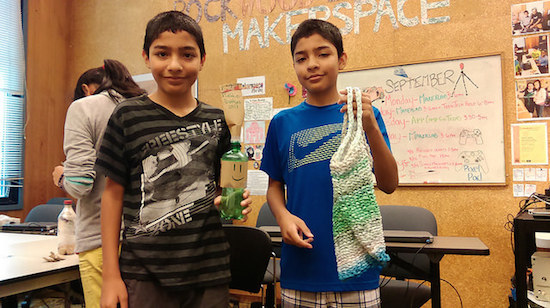Read
Introducing the Teen Hangout at the Loveland Public Library
Teen Hangout, part of the YOUmedia Learning Labs Network, provides afterschool space for youth to...
At the Millvale Community Library in Pennsylvania, toddlers and kids gather weekly to work on creative projects. On those days the library morphs into a “makerspace,” overflowing with sewing supplies, circuitry, yarn, and electronics. The young visitors are encouraged to tinker with the materials and create anything they dream up, be it an animated video or a collage.
The Millvale site is part of a growing group of libraries that have opened up space, permanently or occasionally, for maker projects. Doing so is one way for libraries to experiment with new identities and attract young patrons in the modern age. Books remain an important centerpiece of the library system, but new tools give the institutions opportunities to help young people develop and learn in fresh ways.
Libraries have long served as safe and welcoming places for young people to meet, discover passions, and figure out academic or professional aspirations. The Institute of Museum and Library Services (IMLS), a federal grant-making body, calls libraries “ideal settings for community makerspaces.”
“These spaces strengthen community-based learning, particularly for problem solving, creative thinking, innovation, collaboration, and engagement in STEM (science, technology, engineering, and math),” IMLS says.
Building a makerspace might sound like a daunting task for a traditional library, but in many cases the institutions can focus on what they already do well, said YOUmedia’s K-Fai Steele in an Educator Innovator webinar about youth makerspaces last month. Many libraries have established teen networks and practice connecting youth to each other and outside resources.
 For several years YOUmedia has operated “learning labs” in libraries across the country. Teens can visit those spaces to play around with digital tools and collaborate on creative projects. For many, the library sites have become refuges.
For several years YOUmedia has operated “learning labs” in libraries across the country. Teens can visit those spaces to play around with digital tools and collaborate on creative projects. For many, the library sites have become refuges.
In some cases, makerspaces introduce digital technology into libraries, giving young patrons access to new tools for expression and communication. Other times, there is a “mad dash to getting all this technology in the space” without thoughtful conversation about the visitors’ interests or needs, Steele said.
“It’s not so much about the stuff,” agreed Peter Wardrip, a learning scientist at the Children’s Museum of Pittsburgh. “It’s really about having people in places to manage and facilitate the maker experience.” Wardrip and his colleague Lisa Brahms hit the road last year, visiting upwards of 30 makerspaces hoping to devise a framework for successful makerspaces for IMLS.
Another practical tool for those thinking of building a makerspace in a library or elsewhere is the Youth Makerspace Playbook (PDF) from Maker Ed. The guide, which culls wisdom from several successful makerspaces, offers tips to educators working under a variety of circumstances.
“Our primary interest is equitability and access,” said Steve Davee, director of education at Maker Ed. A key takeaway from the playbook? “There’s no one type of makerspace and you don’t need any specific equipment,” he said.
Lyndsey Runyan, creative learning spaces coordinator at the Multnomah County Library in Portland, Oregon, said one site she worked at got caught in the tech trap Steele described. Receiving a grant for a 3D printer, the staff designed their maker programming entirely around the new tool. But Runyan doubted the users of the library, if surveyed, would have picked 3D printing as their preferred form of making. She tries to check the pulse of the community to see what projects make the most sense.
Now working at the Rockwood Library in an under-resourced area of the county, Runyan views the makerspace “as a place we can dive into multiple literacies,” an important function of a contemporary library. Runyan noted that many of the library’s patrons need support in order to use the computer, but also with basic literacy skills. The library offers tutoring to get patrons up to speed. “We also really like having crafts in our space. We found that makes it inclusive, not only of people at different levels, but also of girls,” who Runyan says sometimes need extra support in order to feel welcome in a makerspace.
For Runyan, makerspaces are an extension of libraries’ age-old engagement with storytelling. Young visitors, many of whom lack platforms for self-expression, are eager to tell tales of their own lives and communities, or about the worlds in their imaginations. It could be a teenager at YOUmedia making a documentary about her neighborhood, or two children at the Rockwood makerspace inventing a family of robots using the Hummingbird Robotics Kit.
For longtime library users, sewing machines and circuitry might initially seem out of place. But strong makerspaces enable libraries to keep doing what they have always done best—helping young people explore the wide world of ideas.
Photos/ Rockwood Makerspace, Multnomah County Library